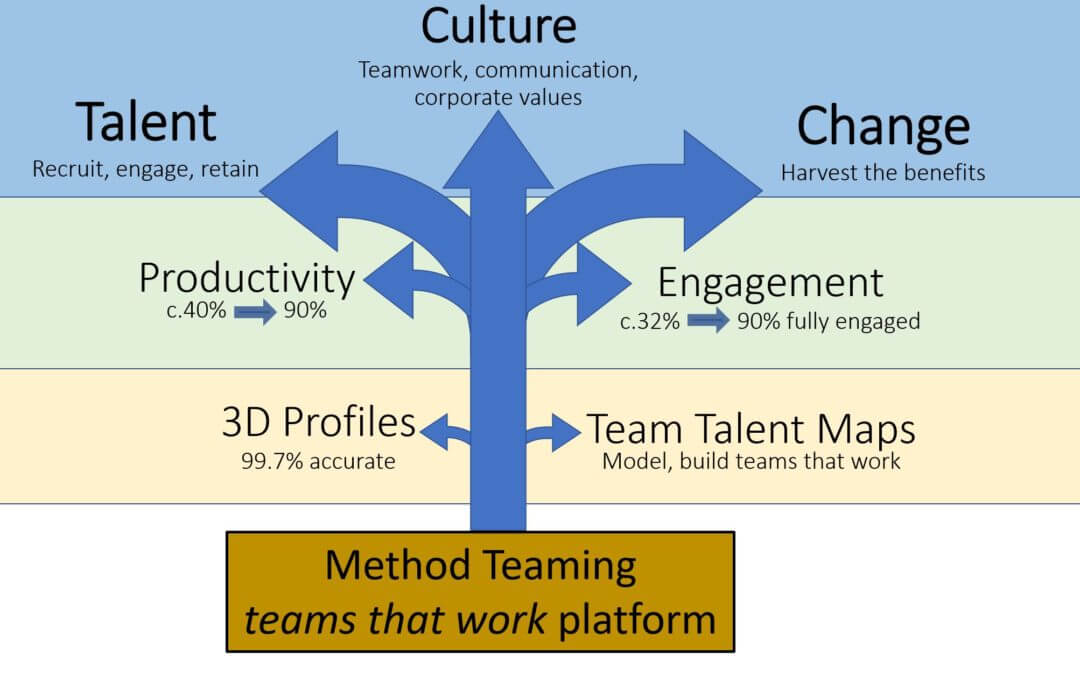First, for those who haven’t read around this site, a quick explanation of ‘talent alignment’. Our talents are abilities that are entirely natural, they lie within us. They are tied to our sense of purpose. Most of us have an urge to discover and put our talents to use. This gives us huge satisfaction when we do. Sometimes talents lay, sadly, dormant until the day we die. Unused talent is a tragedy.
But we must not confuse talent with skill. Skills are learnt. For instance the ability to plaster a wall or work with spreadsheets. These are skills, not talents. Skills do not drive us forward, however. They are things we have picked up, they are not part of us. Unused skills do not leave us restless in the way that undiscovered talent does.
Psychometric tests are an effort to define talent. But most psychometrics are behavioral only and do not tell us much about the type of work we yearn for or where we fit in the team. They also don’t help managers or HR to build teams or departments that actually work together. The proof of this comes from Gallup. Gallup estimates that although most organizations use psychometrics of one flavor or another, they are only using the natural talents of their employees 32% of the time. In other words, 68% of the time, people are doing tasks that are not aligned with their natural talents. Psychometrics are not dealing with the problem.
But you can now start to see what talent alignment is.
When employees are talent aligned with their jobs, their confidence and engagement increases and they become known as reliable experts at what they do. They are mini centres of excellence.
Conversely when workers are performing tasks that are not aligned with their natural talent, they become disengaged. Their performance drops and they become dissatisfied with themselves. They become disconnected from their team and their organization. They are soon looking for another job.
Help is at hand.
Method Teaming is a talent-alignment platform that can not only accurately map someone’s talent, it can also align that person’s talent to their job role and go on from there to align an entire team or department’s talents to its mission. It can ensure everyone is in the right seat for their talent.
The Method Teaming platform can ensure extraordinary levels of employee and team engagement. This in turn is reflected in higher performance as well as increased retention. All of this results in lower costs across the enterprise as knowledge is retained for longer and there is less need for expensive recruitment, training and onboarding.
As if that wasn’t enough already, here is where the story takes a turn for the better.
Talent alignment also brings with it a new way for employees to talk about the work that they do and how they share the work between them. You could call this a new language although it’s really only a dozen or so phrases.
But these dozen phrases are so powerful when properly used that they galvanise the two main components that govern culture: teamwork and communication. Overnight, literally, employees are able to communicate with each other about how they teamwork together, and how to get the best out of themselves and each other, in a way they couldn’t do the day before.
Once talent-aligned, employees are already highly engaged and more productive than they were before. Work quality has risen because people are doing what they were made for. Morale is high.
But when you add improved teamwork and communication on top of high engagement you get the corporate heaven that every CEO and HR head dreams of: a superior culture. There’s a great white paper about culture you can read here.
Some of the big consultancies are drawing up expensive culture programs to sell to their clients. Culture programs are highly mechanistic projects in which employees are shown the error of their former ways and pressured into adopting new patterns of behaviour. So far, there’s little evidence of their success. The risks to enterprises and their employees of setting false hopes are high.
But taking these risks is entirely unnecessary.
Talent alignment delights both employee and employer and delivers immediate benefits of engagement and productivity. Employees love it because they feel able to contribute their best to their employer, sometimes for the first time ever.
But the improved teamwork and communication that emerges when talent-alignment is complete creates, de facto, a far better culture than was there before. And there are no risks. Talent alignment is the gift that keeps on giving.
It’s no wonder talent-alignment is already being hailed as the force behind the next big wave of corporate competitiveness.


